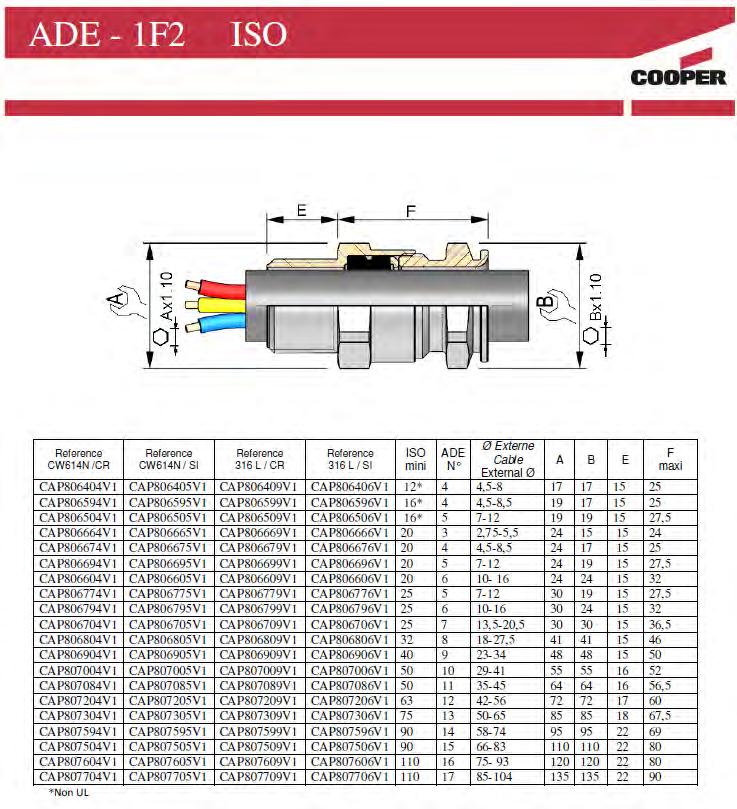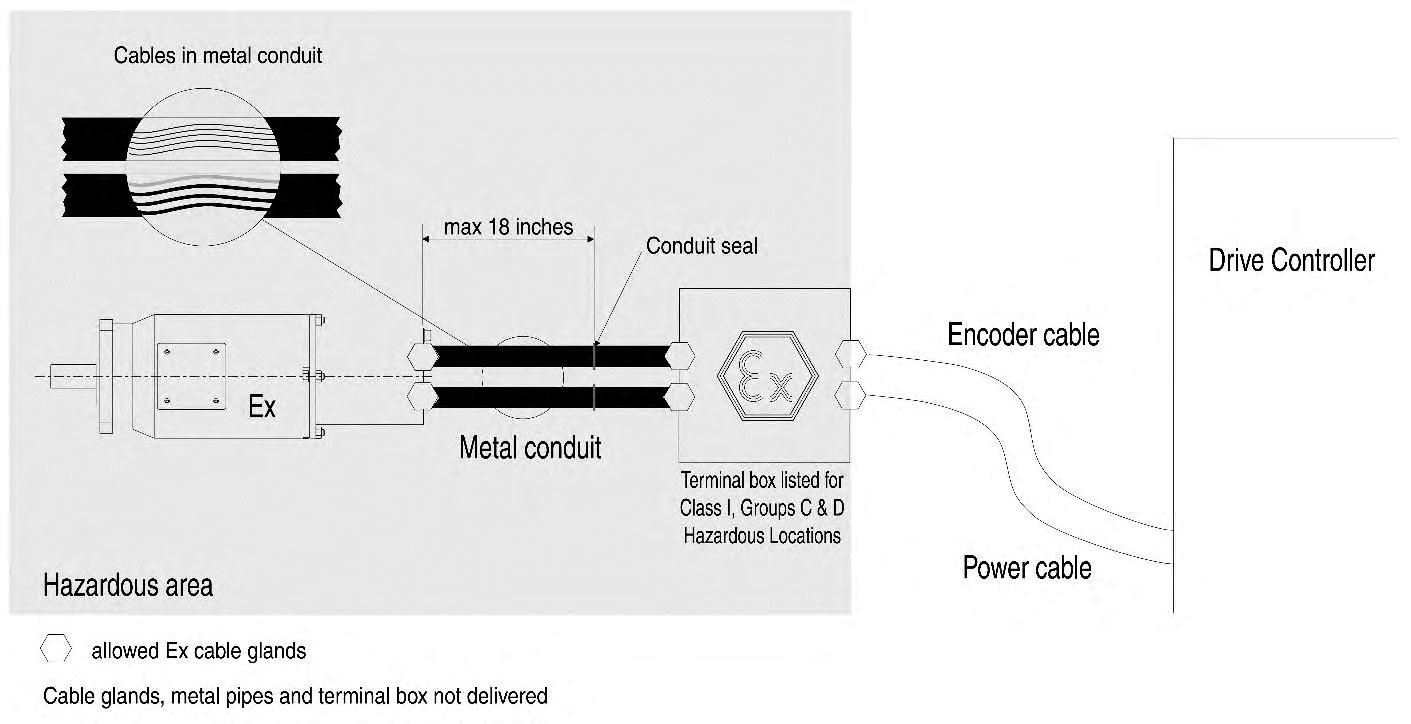
26 minute read
3.2.6.9. Series EX310U (EX310UAU)
3.2.6.10. Series EX420U (EX420UAI)
3.2.6.11. Series EX430U (EX430UAG)
Advertisement
3.2.6.12. Series EX620U (EX620UAM)
3.2.6.13. Series EX630U (EX630UAK)
3.2.6.14. Series
(EX820UAQ)
3.2.6.15. Series
(EX840UAL)
3.2.6.16. Series EX860U (EX860UAJ)
3.2.7. Electromagnetic losses
Caution: Following data result from our best estimations but are indicative They can vary from one motor to another and with temperature. No responsibility will be accepted for direct or indirect losses or damages due to the use of these data.
(Following data are indicative, without lip seal, IP64 motor)
Torque losses (N.m) = Tf + Kd x speed(rpm)/1000
3.2.8. Time constants of the motor
3.2.8.1. Electric time constant:
With following values given in the motor data sheet
Lph_ph inductance of the motor phase to phase [H],
Rph_ph resistance of the motor phase to phase at 25°C [Ohm].
Example:
Motor series EX620EAO
Lph_ph = 14 mH or 14.10-3 H
Rph_ph at 25°C = 1.63 Ohm
elec = 14.10-3/1.63 = 8.6 ms
An overall summary of motor time constants is given a little further
3.2.8.2. Mechanical time constant:
With following values obtained from the motor data sheet:
Rph_ph resistance of the motor phase to phase at 25°C [Ohm],
J inertia of the rotor [kgm²],
Keph_ph back emf coefficient phase to phase [Vrms/rad/s].
The coefficient Keph_ph in the formula above is given in [Vrms/rad/s]
To calculate this coefficient from the datasheet, use the following relation:
Example:
Motor series EX620EAO
Rph_ph at 25°C = 1.63 Ohm
J = 98.10-5 kgm²
Keph_ph [Vrms/1000rpm] = 81.7 [Vrms/1000rpm]
Keph_ph [Vrms/rad/s] = 81.7/(2**1000/60) = 0.7802 [Vrms/rad/s]
mech=0.5*1.63*98.10-5 /(0.7802²) = 1.3 ms
Remarks:
For a DC motor, the mechanical time constant mech represents the duration needed to reach 63% of the final speed when applying a voltage step without any resistant torque. However this value makes sense only if the electric time constant elec is much smaller than the mechanical time constant mech (for the motor EX620EAO taken as illustration, it is not the case because we obtain mech<elec.).
An overall summary of motor time constants is given a little further.
3.2.8.3. Thermal time constant of the copper:
With:
Rth thermal resistance between copper and ambient temperature [°K/W]
Cthcopper thermal capacity of the copper [J/°K] Masscopper mass of the copper (winding) [kg]
Hereunder is given an overall summary of motor time constants:
3.2.9. Speed ripple
The typical speed ripple for a EX motor with a resolver at 4000rpm is 3% peak to peak. This value is given as indicative data because depending on the settings of the drive (gains of both speed and current regulation loops, presence of filtering or not, load inertia, resistant torque and type of sensor in use), without external load (neither external inertia nor resistant torque).
3.2.10. Cogging torque
The typical cogging for a EX series below is the maximum value peak to peak in N.cm:
3.2.11. Rated data according to rated voltage variation
The nominal characteristics and especially the rated speed, maximal speed, rated power, rated torque, depend on the nominal voltage supplying the motor considered as the rated voltage. The rated data mentioned in the data sheet are given for each association of motor and drive. Therefore, if the supply voltage changes, the rated values will also change. As long as the variation of the rated voltage remains limited, for instance to 10% of the nominal value, it is possible to correctly evaluate the new rated values as illustrated below.
Example: Extract of Ex630EAI datasheet
If we suppose that the rated voltage Un=400 Vrms decreases of 10% ; this means that the new rated voltage becomes Un2=360 Vrms
Rated speed:
The former rated speed Nn=3000 rpm obtained with a rated voltage Un=400 Vrms and an efficiency =92% leads to the new rated speed Nn2 given as follows:
Maximum speed:
The former maximum speed Nmax = 3000 rpm obtained with Un =400 Vrms and a speed Nn =3000 rpm leads to the new maximum speed Nmax2 given as follows:
N.B.
If the rated voltage increases (Un2 > Un), the new rated speed Nn2 and the new maximum speed Nmax2 will be greater than the former ones Nn and Nmax. Moreover you will have to check that the drive still shows able to deal with the new maximum electric frequency.
Warning: If the main supply decreases, you must reduce the maximum speed accordingly in order to do not damage the motor. In case of doubt, consult us.
Rated power:
The former rated power Pn=2270 W obtained with Un=400 Vrms leads to the new rated power Pn2 given as follows:
Rated torque: The former rated torque Mn = 7.24 Nm obtained with Un =400 Vrms leads to the new rated torque Mn2 given as follows:
3.2.12. Voltage withstand characteristics of EX series
The motors fed by converters are subject to higher stresses than in case of sinusoidal power supply. The combination of fast switching inverters with cables will cause overvoltage due to the transmission line effects. The peak voltage is determined by the voltage supply, the length of the cables and the voltage rise time. As an example, with a rise time of 200 ns and a 30 m (100 ft) cable, the voltage at the motor terminals is twice the inverter voltage. The insulation system of the servomotors EX is designed to withstand high repetitive pulse voltages and largely exceeds the recommendations of the IEC/TS 60034-25 ed 2.0 200703-12 for motors without filters up to 500V AC (See figure 1).
Motor Pulse Withstand Characteristic Curves
Curve
Figure 1: Minimum Voltage withstands characteristics for motors insulations according to IEC standards. At the top are the typical capabilities for the EX motors.
Note: The pulse rise times are defined in accordance with the IEC/TS 60034-17 ed4.0 200605-09.
The EX motors can be used with a supply voltage up to 480 V under the following conditions:
The pulse rise times must be longer than 50 ns.
The repetitive pulse voltages must not exceed the values given in figure 1, “Curve EX motors” in dark blue.

3.2.13. Voltage and current during the operating
The EX motors carry ATEX and UL certification and due to this certificate, they are subjected to strict rules regarding their use. One of such rules is the us of a servoamplifier that meets specific characteristics.
Warning : EX motors must be connected in accordance with the diagrams given in chapter §4.3.3
3.3. Dimension drawings
3.3.1. EX310E
3.4. Motor Mounting
3.4.1. Motor mounting By flange in any direction
3.4.2. Installation of ATEX machines
Keep in mind that EX motors are equipments with protect mode “db” flameproof enclosure for hazardous area of gas and with protection by enclosure "tb" for hazardous area of dust ignition.
When installing electris system in hazardous locations, carefully observe the corresponding country regulations.
3.4.3. Frame recommendation
Warning : The user has the entire responsibility to design and prepare the support, the coupling device, shaft line alignment, and shaft line balancing.
Foundation must be even, sufficiently rigid and shall be dimensioned in order to avoid vibrations due to resonances. The servomotors need a rigid support, machined and of good quality. The maximum flatness of the support has to be lower than 0.05mm.
The motor vibration magnitudes in rms value are in accordance with IEC 60034-14 grade A: maximum rms vibration velocity for EX is 1.3mm/s for rigid mounting
Warning : A grade A motor (according to IEC 60034-14) well-balanced, may exhibit large vibrations when installed in-situ arising from various causes, such as unsuitable foundations, reaction of the driven motor, current ripple from the power supply, etc.
Vibration may also be caused by driving elements with a natural oscillation frequency very close to the excitation due to the small residual unbalance of the rotating masses of the motor. In such cases, checks should be carried out not only on the machine, but also on each element of the installation. (See ISO 10816-3).
Warning : A bad setting of the electronic control of the close loop (gain too high, incorrect filtring …) can occur an instability of the shaft line, vibration or/and breakdown - . Please consult us
3.5. Shaft Loads
3.5.1. Vibration resistance to shaft end
Frequency domain :10 to 55 Hz according to EN 60068 -2-6
Vibration resistance to the shaft end :
- radial 3 g
- axial 1 g
3.5.2. Maximum load acceptable on the shaft
Warning : The values written in the table are given for a load placed on the middle of the shaft like the picture below.
Warning :
Due to the small ATEX airgap requirements between the shaft and the front flange, the radial loads on the shaft are lower than standard NX motors.
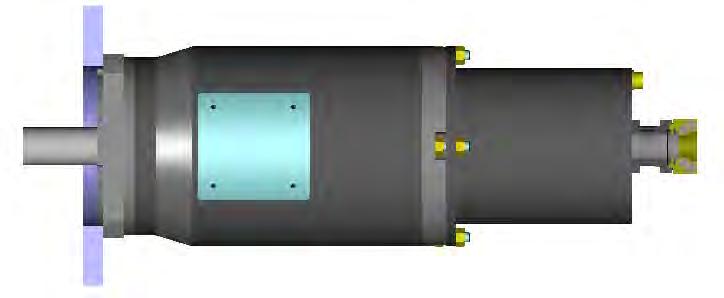
The ATEX airgap requirements depend on the volume of the motor and can lead to lower radial loads for bigger motors.
Warning :
Regarding to these shaft loads, you must’nt use a pulley belt system without a load take-up system.
3.6. Cooling
In compliance with the IEC 60034-1 standards: The ambient air temperature shall not be less than -20°C and more than 40°C.
It is possible to use the motors in an higher ambient temperature between 40°C to 60°C but with an associated derating to the motor performances.
Warning: To reach the motor performances calculated, the motor must be thermally well connected to a aluminium flange with a dimension of 400 mm x 400 mm and with a thickness of 12 mm.
Caution: the ambient air temperature shall not exceed 40°C (respectively 60°C with associated derating) in the vicinity of the motor flange
Warning: A significant part of the heat produced by the motor is evacuated through the flange.
if the air is not able to circulate freely around the motor,
if the motor is mounted on a surface that dissipates not well the heating (surface with little dimensions for instance),
if the motor is thermally isolated,
if the motor is mounted on a warm surface (mounted on a gearbox for instance), then the motor has to be used at a torque less than the rated torque.
3.7. Thermal Protection
The drive guarantees a 1st level of safety but it is not sufficient. Safety is guaranteed by the independent relay system described in the connection diagram (§4.3.3) which constitutes an independent protection circuit meeting safety classification SIL2 in accordance with the standard IEC 61508.
In the motor, there are two kinds of thermal sensors used for the safety. Both devices are wired in-series with the coil of the drive power contactor.
Two thermoswitches fitted in the servomotor coil mean that the circuit is mechanically opened on a basis at 125°C±5°C. This protection is reversible, after a decreasing of the temperature under the basis, the circuit is mechanically closed.
A thermofuse fitted with a contact on the servomotor frame means that the circuit is mechanically opened on a permanent basis at 130°C-5°C. In case of an over temperature and thermoswitches default, the thermo fuse cuts off permanently the power supply to the contactor coil. Both thermoswitches and thermofuse are wired in-series with the coil of the drive power contactor. If the maximum temperature is reached, the thermoswitches are opened and temporarily cut off the power supply to the contactor coil. If the temperature reaches a dangerous level (thermoswitches default), the thermofuse melts; permanently cutting off the power supply to the contactor coil.
The drive can be equipped with a Safe Torque Off function in accordance with EN ISO13849-1 : 2006 and EN 61800-5-2:2006 and validated by a notified organization. In this case the safety system can be connected to this function with a validation of a notified organization.
Caution : (see diagrams §4.3.3) :
Make sure the parameters of the contactor and the connecting are strictly followed.
The motor is out of order if the thermofuse is activated!
The power contactor KM1 should be replaced in accordance with its operation lifespan and number of manoeuvres. A yearly test, intended to check on the ability of the contactor to detect condition changes, should also be carried out.
The thermal sensors, due to their thermal inertia, are unable to follow very fast winding temperature variations. They acheive their thermal steady state after a few minutes.
Warning: To protect correctly the motor against very fast overload, please refer to 3.1.6. Peak current limitations
3.8. Power Electrical Connections
3.8.1. Inlet cables for ATEX/IECEx version.
The servomotors EX have two cable glands with metric thread :one for the feedback cable and the other for the power. These cable glands are place in axial or radial position on the feedback cover depending the motor option.
The informations of these cable glands are placed in the §4.4.
The cable gland expected for the feedback cable could be replace by an ATEX thread cap in case of a servomotor in sensorless.
It is forbidden to change a cable gland without the Parker agreement.
3.8.2. Wires sizes
In every country, you must respect all the local electrical installation regulations and standards
Not limiting example in France: NFC 15-100 or IEC 60364 as well in Europe
Cable selection depends on the cable construction, so refer to the cable technical documentation to choose wire sizes
Some drives have cable limitations or recommendations; please refer to the drive technical documentation for any further information.
Cable selection
At standstill, the current must be limited at 80% of the low speed current Io and cable has to support peak current for a long period. So, if the motor works at standstill, the current to select wire size is
2 x 0.8 Io 1,13 x Io.
For the ATEX installations in ambient temperature of 40°C or 60°C, you have to use special cables C2 type auto-extinguish regarding the standard EN 50265-2-1.
Warning : the cables used in the :
EX3 can reach a temperature of 80°C,
EX4 can reach a temperature of 91°C,
EX6 can reach a temperature of 95°C,
EX8 can reach a temperature of 95°C
Warning : for a safe use, the EX3 servomotors has to be used with cable which withstand a maximum temperature of 80°C.
Warning : for a safe use, the EX4/EX6/EX8 servomotors has to be used with cable which withstand a maximum temperature of 100°C.
It is mandatoryto connect 2 (green-yellow) ground cables between the motor frame and machine.
the first one is connected to ground screw on the PCB inside the motor,
the other one is connected to the external motor housing The connecting of these two grounding devices is mandatory in order to comply with ATEX standard IEC/EN 60079-0.
The ground cable cross-section must be the same as the power cable crosssection
3.8.4. Motor cable length
For motors windings which present low inductance values or low resistance values, the own cable inductance, respectively own resistance, in case of large cable length can greatly reduce the maximum speed of the motor. Please contact PARKER for further information.
Caution: It might be necessary to fit a filter at the servo-drive output if the length of the cable exceeds 25 m. Consult us.
The length of the cable must be of 3 meters min.
3.8.5.
3.8.5.1.
3.8.6. ATEX/IECEx motor conenction
3.8.6.1. Connection of the power and the feedback cables with terminals
Step 1 – Remove the rear cover :
1. Unscrew the 4 nuts Ref 1.
2. Unscrew the cable gland caps Ref 2.
3. Remove the cover Ref 3.
Step 2 – Connection of the feedback cable :
1. Insert the cable in the cable gland Ref 2.
2. Strip the wires on 3 mm.
3. Put the wires in the terminals on the PCB Ref 4 and tighten each screws at the torque value of 0,6 N.m.
4. Make the shielding connection with the connection of the terminal on the screw Ref 5 at the torque value of : Motor size Torque (N.m) EX3-EX4 M3 screw 1,7
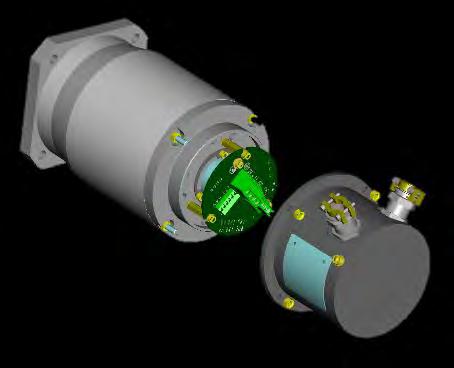
M4 screw 2,5
5. If the shielding connection is not necessary, cut the wire short the cable.
Step 3 – Connection of the power cable :
1. Insert the cable in the cable gland Ref 2.
2. Strip the wires on 3 mm.
3. Put the wires U, V, W, Ground, TH+ and TH- and also BR+ and BR- in a case of a motor with a brake in the terminal of the PCB Ref 4 and tighten each screws at the torque value of 0,6N.m.
4. Make the shielding connection with the connection of the terminal on the screw Ref 5 at the torque value of :
5. If the shielding connection is not necessary, cut the wire short the cable
Step 4 – Fitting of the rear cover :
1. Slowly take up any slack in the cables and close the cover Ref 3.
2. Tighten the cable gland caps Ref 2 at the torque value of :
3. Tighten the screws of the connection modules Ref 6 at the torque value of 0,5 N.m.
4. Place the rear cover Ref 3 and take care to don’t hurt the toric seal placed on the rear flange
5. Tighten the 4 nuts Ref 1 at the torque value of :
6. Connect the outside ground with the screw Ref 7 and tighten it at the torque value of :
3.8.6.2. Connection of the feedback and power cable with connector on EX3 :
Step 1 – Remove the rear cover :
1. Unscrew the 4 nuts Ref 1.
2. Unscrew the cable gland caps Ref 2.
3. Remove the cover Ref 3.
Step 2 – Connection of the feedback cable :
1. Insert the cable in the cable gland Ref 2.
2. Strip the wires on 3 mm and crimp them in the connector.
3. Plug the connector in the terminal of the PCB Ref 4 .

4. Crimp the shielding wire in the connector and plug the connector in the terminal Ref 5.
5. If the shielding connection is not necessary, cut the wire short the cable.
Step 3 – Connection of the power cable :
1. Insert the cable in the cable gland Ref 2.
2. Strip the wires on 3 mm and crimp them in the connector
3. Put the wires U, V, W, Ground, TH+ and TH- and also BR+ and BR- in a case of a motor with a brake equiped with their connectors on the terminal of the PCB Ref 4.
4. Crimp the shielding wire in the connector and place the connector in the terminal Ref 5.
5. If the shielding connection is not necessary, cut the wire short the cable
Step 4
– Fitting of the rear cover :
1. Slowly take up any slack in the cables and close the cover Ref 3.
2. Tighten the cable gland caps Ref 2 at the torque value of :
Cable gland size Torque (N.m) M16 12,5 M20 20
3. Tighten the screws of the connection modules Ref 6 at the torque value of 0,5 N.m.
4. Place the rear cover Ref 3 and take care to don’t cut the toric seal placed on the rear flange.
5. Tighten the 4 nuts Ref 1 at the torque value of 5,6 N.m.
6. Connect the outside ground with the screw Ref 7 and tighten it at the torque value of 2,5 N.m.
3.8.7. EX3-EX4 UL connection
3.8.7.1. Connection of the feedack and power cable with connector:
Step 1 – Remove the rear cover:
1. Unscrew the 4 nuts Ref 1.
2. Unscrew the cable gland caps Ref 2.
3. Remove the cover Ref 3.
Step 2 – Connection of the feedback cable :
1. Insert the cable in the cable gland or conduit stop Ref 2.
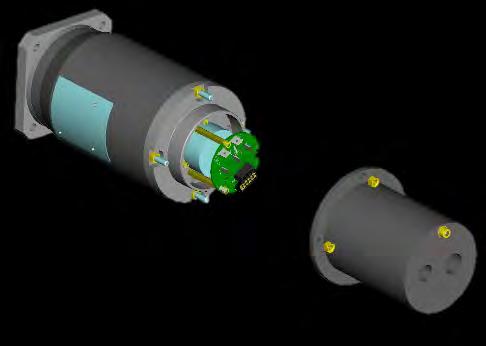
2. Strip the wires on 3 mm and crimp them on the contacts supplied in the terminal part kit with the manual crimp tooling Molex N°0638190000 for wire diameter AWG 20-24.
3. Place the contacts in the connector Ref 8.
4. Place the connector inside the PCB connector Ref 4.
5. Crimp the shielding wire in the connector and plug the connector in the terminal Ref 5.
6. If the shielding connection is not necessary, cut the wire short the cable
Step 3 – Connection of the power cable :
1. Insert the cable in the cable gland or conduit stop Ref 2.
2. Strip the wires on 5mm and crimp the wires U, V, W and Ground in the faston terminals 6,8x0,8.
3. Place the wire U, V, W and Ground on the terminals and plug the wires TH+ and TH- and also BR+ and BR- in a case of a motor with a brake equiped in the terminal of the PCB Ref 4 .
4. Crimp the shielding wire in the faston terminal 2,8x0,8 and plug it on the terminal Ref 5.
5. If the shielding connection is not necessary, cut the wire short the cable
Step 4 – Fitting of the rear cover :
1. Slowly take up any slack in the cables and close the cover Ref 3.
2. Tighten the cable gland caps or conduits stop Ref 2.
3. Tighten the screws of the connection modules Ref 6 at the torque value of 0,5 N.m.
7. Place the rear cover Ref 3 and take care to don’t hurt the toric seal placed on the rear flange.
4. Tighten the 4 nuts Ref 1 at the torque value of 5,6 N.m.
5. Connect the outside ground with the screw Ref 7 and tighten it at the torque value of:
3.8.8. EX6-EX8 UL connection
3.8.8.1. Connection of the feedack and power cable with terminal:
Step 1 – Remove the rear cover :
1. Unscrew the 4 nuts Ref 1.
2. Unscrew the cable gland caps Ref 2.
3. Remove the cover Ref 3.
Step 2 – Connection of the feedback cable :
1. Insert the cable in the cable gland Ref 2.
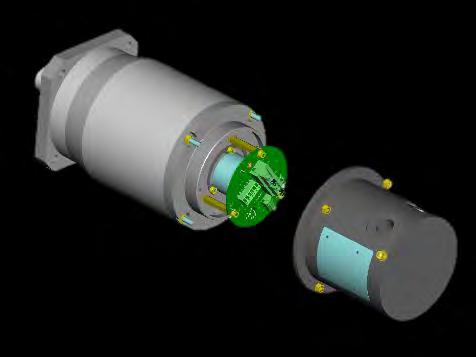
2. Strip the wires on 3 mm.
3. Put the wires in the terminals on the PCB Ref 4 and tighten each screws at the torque value of 0,6 N.m.
4. Make the shielding connection with the connection of the terminal on the screw M4 Ref 5 at the torque value of 2,5 N.m.
5. If the shielding connection is not necessary, cut the wire short the cable.
Step 3 – Connection of the power cable :
1. Insert the cable in the cable gland Ref 2.
2. Strip the wires on 3 mm
3. Put the wires U, V, W, Ground, TH+ and TH- and also BR+ and BR- in a case of a motor with a brake in the terminal of the PCB Ref 4 and tighten each screws at the torque value of 0,6N.m.
4. Make the shielding connection with the connection of the terminal on the screw ref 5 at the torque value of 2,5 N.m.
5. If the shielding connection is not necessary, cut the wire short the cable.
Step 4 – Fitting of the rear cover :
7. Slowly take up any slack in the cables and close the cover Ref 3.
8. Tighten the cable gland caps or conduits stop Ref 2.
9. Place the rear cover Ref 3 and take care to don’t hurt the toric seal placed on the rear flange
10.Tighten the 4 nuts Ref 1 at the torque value of :
11. Connect the outside ground with the screw Ref 7 and tighent it at the torque value of :
3.9. Feedback system
3.9.1. Shaft rotation regarding the connection. With the connection explained in the documentation and with a positive speed request on the drive, the shaft will turn in clockwise direction (see customer shaft end).
3.9.2. Resolver 2 poles transformation ratio = 0.5 – code A
Output
(primary in short circuit whatever the position of the
Dielectric
3.9.3. Sensorless – code K or Y.
The servomotors EX in sensorless version do not have a feedback cable. The connection of the power cable has to be made regading the connection diagrams in this documentation. In these detailed diagrams §4.3.3, do not take care the connection of the feedback cable and keep the same connections for the other devices
EX3, EX4, EX6 & EX8
SKS36 (Sick) single turn encoder
Integral non-linearity ± 80’’(Error limits for evaluating sine/cosine period)
Differential non-linearity ± 40’’ (Non-linearity within a sine/cosine period)
EX3, EX4, EX6 & EX8
SKM36 (Sick)
Absolute multi turn encoder
Integral non-linearity ± 80’’(Error limits for evaluating sine/cosine period)
Differential non-linearity ± 40’’ (Non-linearity within a sine/cosine period)
3.9.6.
SRS50 (1024pulses) – code T EX4, EX6 & EX8
3.9.7.
SRM50 (1024pulses) – code U
EX6 & EX8 encoder singleturn ECN1113 – code V
3.9.8.
EX3 & EX4 ATEX EX3 UL, EX4 UL, EX6 & EX8
1113 (Heidenhain) Type Absolute single turn encoder encoder multiturn ECN1125 – code W
3.9.9.
EX3 & EX4 ATEX EX3 UL, EX4 UL, EX6 & EX8
With unregulated power supply (AC890 PARKER drive for instance), the max cable length is 65m with 0.25mm² power supply wire due to the voltage drop into the cable itself.
Maximum Endat cable length
Please refer to the following curve to calculate the max cable length depending on the clock frequency
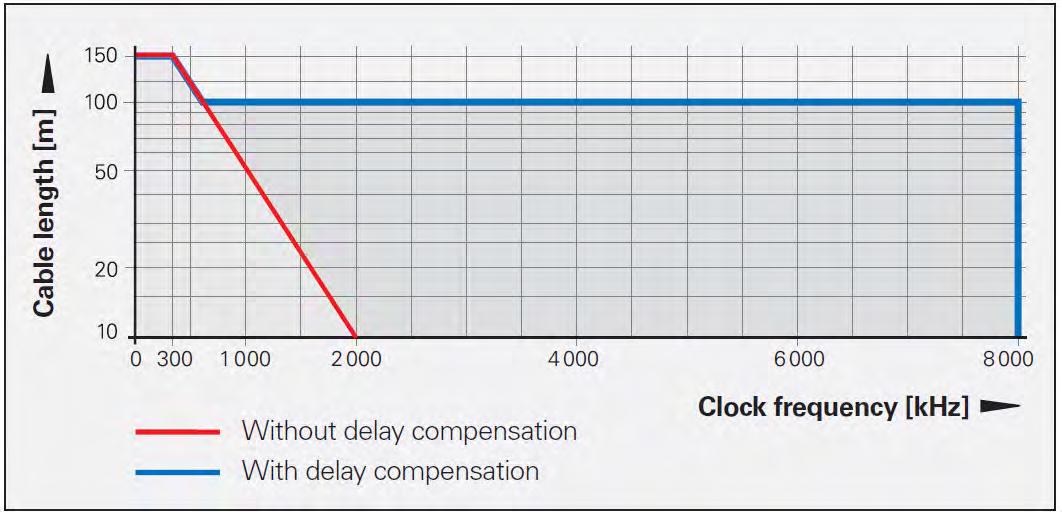
AC890 PARKER Wiring – EnDat encoder From Heidenhain
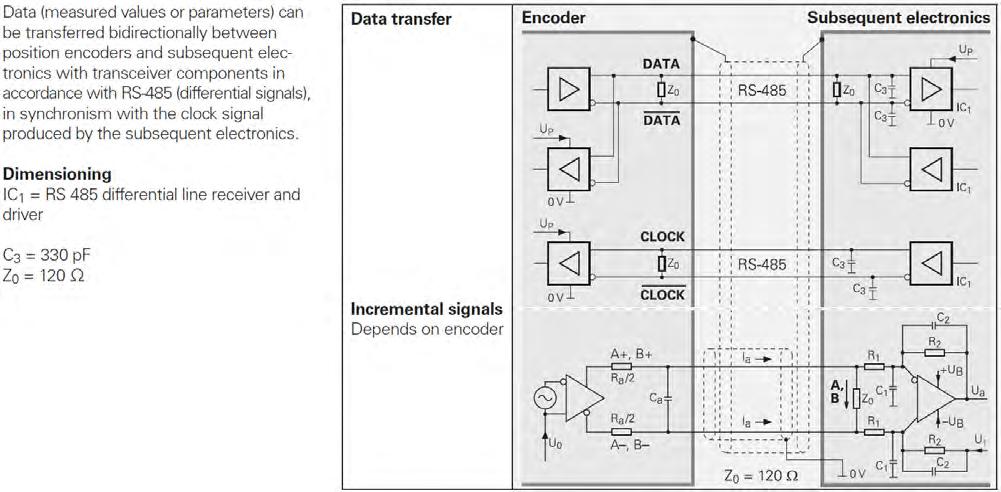
3.9.10. Incremental encoder - Commuted lines 10 poles – 2048pulses –code X (On request)
EX3, EX4, EX6 & EX8
Model F10 (Hengstler)
Type Incremental encoder with 10 pole commutation signals
Parker part number 220167P0003
Line count 2048 pulses per revolution
Electrical interface Line driver 26LS31
System accuracy
Incremental signals ± 2.5' commutation signals ± 6'
3.10. Cables
You can connect EX motors to PARKER servo drives : AC30, AC890, COMPAX3, PSD or SLVD.
You can use complete cable with part number on the tabs below. The "xxx" in the part number must be replaced by the length in meter with a minimal length of 3m Ex : for 20m cable, "xxx" = 020.
Special requirements for ATEX servomotors
For the ATEX installations in ambient temperature of 40°C or 60°C, you have to use special cables C2 type auto-extinguish regarding the standard EN 50265-2-1
Warning : the cables used in the :
EX3 can reach a temperature of 80°C,
EX4 can reach a temperature of 91°C,
EX6 can reach a temperature of 95°C,
EX8 can reach a temperature of 95°C
Warning : for a safe use, the EX3 servomotors has to be used with cable which withstand a maximum temperature of 80°C.
Warning : for a safe use, the EX4/EX6/EX8 servomotors has to be used with cable which withstand a maximum temperature of 100°C.
3.10.1. Cable option Max 80°C on the surface ATEX/IECEx
The servomotors EX are available on demand with cables withstanding a temperature of 80°C on the outside surface. With this option the EX servomotors must be placed in an area with controlled temperature following the informations written in the tables just below. An over temperature must cut off the power of the motor.
Size EX4 :
Ambient temperature for a Parker standard cable using (Max 100°C)
Ambient temperature for an using of cables withstanding a max temperature of 80°C.
Size EX6 :
Ambient temperature for Parker standard cable using (Max 100°C)
Ambient temperature for an using of cables withstanding a max temperature of 80°C.
Size EX8 :
Ambient temperature for Parker standard cable using (Max 100°C)
Ambient temperature for an using of cables withstanding a max temperature of 80°C.
EX4 certified for an ambient temperature of -20 to +60°C
-20 to +60°C
-20 to +49°C
EX6 certified for an ambient temperature of -20 to +40°C to +40°C
EX8 certified for an ambient temperature of20 to +40°C
-20 to +40°C
-20 to +25°C
EX6 certified for an ambient temperature of -20 to +60°C to +60°C
3.10.2. Resolver cable connection for AC890
Cable reference : CS4UA1D1R0xxx
Feedback cable 6537P0059
Male 15 pins SUB-D connector reference AC 80552
SUB-D cover reference 220029P0043
Pins reference 220029P0021
Cable arrangement :
3.10.3. Endat cable connection for AC890
Cable reference :
CS4UV1D1R0xxx
Feedback cable 6537P0059
Male 15 pins SUB-D connector reference AC 80552
SUB-D cover reference 220029P0043
Pins reference 220029P0021
3.10.4. Resolver cable connection for COMPAX3
Cable reference : CC3UA1D1R0xxx
Feedback cable 6537P0059
Male 15 pins SUB-D connector reference 220029P0040
SUB-D cover reference 220029P0039
Cable
3.10.5. Hiperface encoder cable connection for COMPAX3
Cable reference : CC3UR1D1R0xxx
Feedback cable 6537P0059
Male 15 pins SUB-D connector reference 220029P0040
SUB-D cover reference 220029P0039
Cable arrangement :
3.10.6. Resolver cable connection for SLVD
Cable reference : CS5UA1D1R0xxx
Feedback cable 6537P0059
Male 15 pins SUB-D connector reference 220029P0040
SUB-D cover reference 220029P0039
Cable arrangement :
3.10.7. Resolver cable connection for 637/638
Cable reference : CS1UA1D1R0xxx
Feedback cable 6537P0059
Male 9 pins SUB-D connector reference 220029P0020
SUB-D cover reference 220029P0039
Pins reference 220029P0021
Cable arrangement :
3.10.8. Hiperface encoder cable connection for 637/638
Cable reference : CS2UR1D1R0xxx
Feedback cable 6537P0059
Male 9 pins SUB-D connector reference 220029P0020
SUB-D cover reference 220029P0039
Pins reference 220029P0021 Cable
3.10.9. Feedback cable reference
For other drive, you can assembly cable and plug by soldering with part number on the tab below:
Feedback Sensor
Resolver
Hiperface Encoder
EnDat Encoder
Cable reference (C2 / 100°C)
6537P0059
3.10.10. Power cable for AC890
Cable reference :
CS4UQ1D1R0xxx for current ≤ 12Amps Power cable 6537P0057
CS4UQ2D1R0xxx for current ≤ 24Amps Power cable 6537P0058
Cable
3.10.11. Power cable for COMPAX3
Cable reference :
CC3UQ1D1R0xxx for current ≤ 12Amps Power cable 6537P0057
CC3UQ2D1R0xxx for current ≤ 24Amps Power cable 6537P0058
3.10.12. Power cable for SLVD
Cable reference :
CS5UQ1D1R0xxx for current ≤ 12Amps Power cable 6537P0057
CS5UQ2D1R0xxx for current ≤ 24Amps Power cable 6537P0058
Cable
3.10.13. Power cable for 637/638
Cable reference :
CS2UQ1D1R0xxx for current ≤ 12Amps Power cable 6537P0057
CS2UQ2D1R0xxx for current ≤ 24Amps Power cable 6537P0058
Cable arrangement :
3.10.14. Power cable reference
For other drive, you can assembly cable and plug by soldering with part number on the tab below:
Ampacity Cable reference (C2 / 100°C)
Current ≤ 12Amps @40°C
Current ≤ 9Amps @60°C 6537P0057
Current ≤ 24Amps @40°C
Current ≤ 17Amps @60°C
3.11. Brake option
Caution: The holding brake is used to completely immobilize the servomotor under load. It is not designed to be used for repeated dynamic braking ; dynamic braking must only be used in the case of an emergency stop and with a limited occurance depending on the load inertia and speed.
The standard brake power supply is 24 Vcc DC ± 10%. Follow the polarity and the permissible voltage, and use shielded cables. A 220 µF capacitor avoids untimely braking if the 24 V voltage is disturbed by the external relay. Check the voltage value once this capacitor has been fitted. The RC network (220 Ω, 0.1 µF) is needed to eliminate interference produced by the brake coil. Position the contactor in the DC circuit to reduce brake response times. Follow the connection instructions taking the brake polarisation into account.
Table with typical values
4. COMMISSIONING, USE AND MAINTENANCE
4.1. Instructions for commissioning, use and maintenance
4.1.1. Equipment delivery
All servomotors are strictly controlled during manufacturing, before shipping. While receiving it, it is necessary to verify motor condition and if it has not been damaged in transit Remove it carefully from its packaging. Verify that the data written on the label are the same as the ones on the acknowledgement of order, and that all documents or needed accessories for user are present in the packaging.
Warning: In case of damaged material during the transport, the recipient must immediately make reservations to the carrier through a registered mail within 24 h.
4.1.2. Handling
The servomotors EX8 are equipped with two lifting rings intended for handling.
Caution: Use only servomotors lifting rings, if present, or slings to handle the motor. Do not handle the motor with the help of electrical cables, connectors and water inputs/outputs, or use any other inappropriate method.
The drawings below show the correct handling procedure.
DANGER: Choose the correct slings for the motor weight. The two slings must the same length and a minimum angle of 50° has to be respected between the motor axis and the slings.
4.1.3. Storage
Before being mounted, the motor has to be stored in a dry place, without rapid or important temperature variations in order to avoid condensation
During storage, the ambient temperature must be kept between -20 and +60°C.
If the torque motor has to be stored for a long time, verify that the shaft end, feet and the flange are coated with corrosion proof product.
After a long storage duration (more than 3 month), run the motor at low speed in both directions, in order to blend the bearing grease spreading.
4.2. Installation
4.2.1. Mounting
Foundation must be even, sufficiently rigid and shall be dimensioned in order to avoid vibrations due to resonance. Before bolting the motor, the foundation surface must be cleaned and checked in order to detect any excessive height difference between the motor locations. The surface variation shall not exceed 0,1 mm. In all cases, we recommend using shims in order to compensate small irregularities.
Caution: The user bears the entire responsibility for the preparation of the foundation.
4.2.2. Torque value for the screws
The table below gives the average tightening torques required regarding the fixing screw diameter. These values are valid for both motor’s feet and flange bolting.
Warning: After 15 days, check all tightening torques on all screw and nuts.
4.2.3. Preparation
Once the motor is installed, it must be possible to access the wiring, and read the manufacturer’s plate. Air must be able to circulate around the motor for cooling purposes. Clean the shaft using a cloth soaked in white spirit or alcohol. Pay attention that the cleaning solution does not get on to the bearings. The motor must be in a horizontal position during cleaning or running.
Caution: Do not step on the motor or the cable glands.
Caution: Always bear in mind that some parts of the surface of the motor can reach a temperature of 135°C
4.2.4. Mechanical assembly
The operation life of servomotor bearings depends largely on the care and attention given to this operation
In the event that the servomotor shaft has a cotter pin, make sure that the coupling components have been balanced correctly without the cotter pin, the servomotor having been balanced with its cotter pin.
Prohibit any impact on the shaft and avoid press fittings which could mark the bearing tracks. If press fitting cannot be avoided, it is advisable to immobilize the shaft in motion; this solution is nevertheless dangerous as it puts the resolver at risk.
Use the thread at the end of the shaft in accordance with the diagram for fitting pulleys or accessories. It is possible to put pressure on the shoulder of the shaft located in front of the bearing.
In the event that the front bearing block is sealed by a lip seal which rubs on the rotating section (version IP 65), we recommended that you lubricate the seal with grease thus prolonging its operational life.
In the event that the drive system uses a pulley and belt, the drive pulley must be fixed as close as possible to the flange. The pulley diameter is to be selected so that the radial load does not exceed the limits given in the catalog.
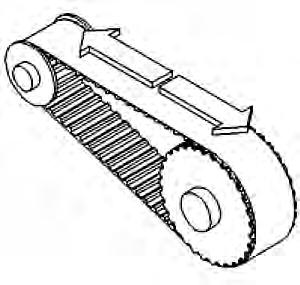
CAUTION: Any equipment such as gearbox, mechanical speed drives, brakes, forced ventilation, integrated frequency converters, sensors, actuators, etc. associated with the motor must also have ATEX certification.
Warning : a misalignment of the coupling device makes stress and load on the motor shaft depending the rigidity of the installation The variations of the temperature makes stress and load due to the dilatation. These loads (axials and radiale) do not exceed the load written (§ 3.5).
Warning : The misalignment of the coupling device makes vibration who can realize a destruction of the motor shaft.
We cannot be held responsible for wear on the drive shaft resulting from excessive strain.
4.3. Electrical connections
Danger: Check that the power to the electrical cabinet is off prior to making any connections.
Caution: The wiring must comply with the drive commissioning manual and with recommended cables.
Danger: The motor must be earthed by connecting to an unpainted section of the motor.
Caution: After 15 days, check all tightening torques on cable connection.
4.3.1. Cable connection
Please, read §3.8 "Electrical connection" to have information about cable connection Many useful informations are already available in the drive documentations.
4.3.2. Encoder cable handling
Danger: before any intervention the drive must be stopped in accordance with the procedure.
Caution: It is forbidden to disconnect the Encoder cable under voltage (high risk of damage and sensor destruction).
Warning: Always wear an antistatic wrist strap during encoder handling.
Warning: Do not touch encoder contacts (risk of damage due to electrostatic discharges ESD.
4.3.3.
4.3.3.1.
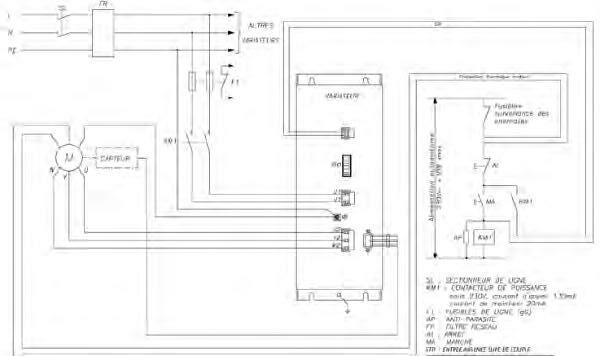

The safe torque off function is an alternative solution for the motor temperature monitoring.
The safe torque off function in accordance with the standards EN ISO 13849-1 : 2006 and EN 61800-5-2 : 2006 is an electronic system set up on some drives certified by a notified body. This is an unlocked input placed on the drive that must be connected (see the commissioning and use manual of the drive).
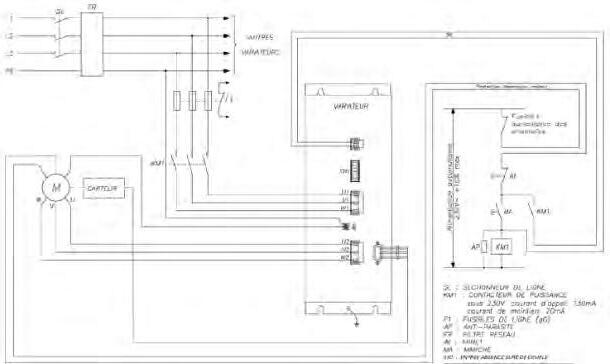
The servomotors EX are equiped with a thermal protection which is checked by a safety analysis and is a key element of the ATEX/IECEx safety. It is possible to connect this protection to the unlocked input or through a safety system in accordance to the drive specifications. This connection allows to maintain the drive power on, but disable the motor after the activation of the thermal protection.
After an activation of this security device, the system must not restart automatically and without a checking of the installation.
In all cases, the connection of this device must be checked and certified by a notified body.
4.3.4. Cable glands informations (Only ATEX/IECEx)
4.3.4.1. Technical data
4.3.4.2. Torque value
M16 Cable glands ADE N°5 : Torque value for the cap = 12,5 N.m
Torque value for the connection module = 0,5 N.m
M20 Cable gland ADE N°6 : Torque value for the cap = 20 N.m
Torque value for the connection module = 0,5 N.m
